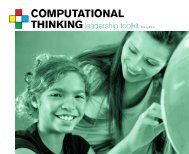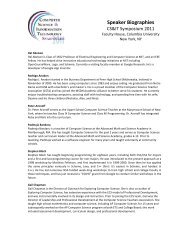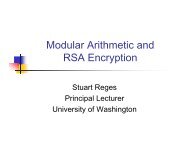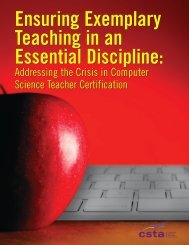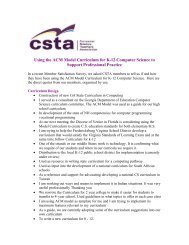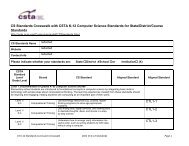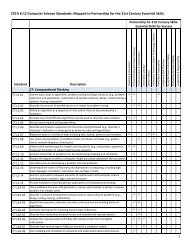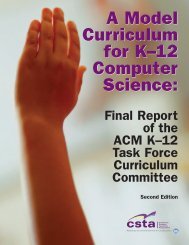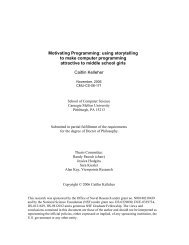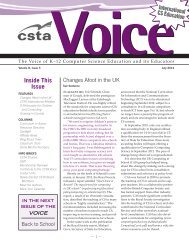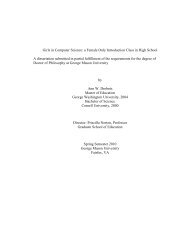Computational Thinking Teacher Resources - CSTA
Computational Thinking Teacher Resources - CSTA
Computational Thinking Teacher Resources - CSTA
You also want an ePaper? Increase the reach of your titles
YUMPU automatically turns print PDFs into web optimized ePapers that Google loves.
Introduction to <strong>Computational</strong> <strong>Thinking</strong> <strong>Teacher</strong> <strong>Resources</strong>The CT <strong>Teacher</strong> <strong>Resources</strong> include:Operational Definition of <strong>Computational</strong> <strong>Thinking</strong> for K–12 EducationISTE and <strong>CSTA</strong> achieved consensus among educators in the field around core skills and dispositions thatdescribe what CT skills all students should have when they graduate from high school.<strong>Computational</strong> <strong>Thinking</strong> Vocabulary and Progression ChartThis chart “unpacks” the operational definition by listing CT concepts implicit in the operational definition,as well as “bite-sized” examples at each grade band and in multiple content areas. While not a scope andsequence of skills, the chart shows a progression of CT activities that grow more sophisticated as studentsprogress through their education.<strong>Computational</strong> <strong>Thinking</strong> Learning Experiences (CTLEs)The CTLEs are a small sample of prototype learning experiences formatted to resemble a lesson or unitplan. The eight CTLEs include a “CT Guide on the Side” meant to emphasize CT components, dispositions,and vocabulary included in the CTLE. The CTLEs illustrate CT highlighted in activities, why these areconsidered CT activities, and how you may evaluate your own lesson or unit plans by recognizing,highlighting, and embedding CT into them.<strong>Computational</strong> <strong>Thinking</strong> ScenarioThis narrative illustrates how CT is implemented and assessed in the classroom.The companion to these resources isthe <strong>Computational</strong> <strong>Thinking</strong> LeadershipToolkit, which makes the case for thepower of CT, why CT is important forall students, and why CT is importantnow. CT is a very new field and few, ifany, people would call themselves CTexperts—including <strong>CSTA</strong> and ISTE.Jeannette Wing set out to articulate CTin 2006. We are not updating a wellestablishedcurriculum. We are beginningto define the CT domain for K–12education. So, you will likely discoverthat the CT skills are not discrete; theyoverlap and intersect with each other;and sometimes understanding CT can bechallenging and messy because of theinconsistencies and lack of clear answers.Our hope is that you develop anunderstanding of CT and recognizethe CT skills and dispositions you arealready including in your lessons andunits. Consider re-examining yourcurrent lessons or units with an eye toextending an activity with CT, take part ina professional learning network to engagewith others new to CT, find other CTresources (there are excellent CT activitiesand lesson plans from other organizations),and request other CT resources that wouldhelp you implement CT in the classroom.The promise of CT is that it can empowerstudents with the skills they need tobecome effective and confident problemsolvers in a complex world.5Table of Contents



